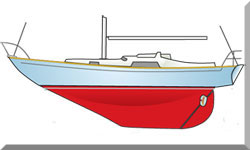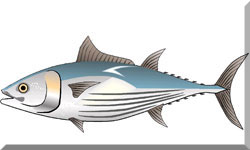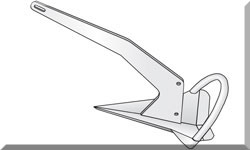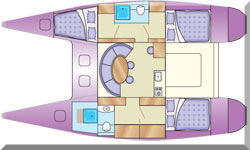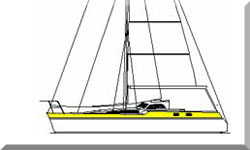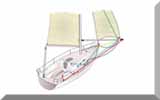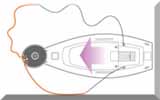- Home
- Beneteau Sailboats
- Beneteau Oceanis 36CC
The Beneteau Oceanis 36CC
Specs, Data & Key Performance Indicators
The Beneteau Oceanis 36CC (Centre Cockpit) is a capable, mid-sized cruising yacht designed for comfortable, extended stays afloat rather than racing performance. Its defining centre cockpit and aft owner's cabin layout provide exceptional privacy and security offshore, making it an excellent choice for a sailing couple who prioritise liveaboard comfort and ease of handling over blistering speed.
 Beneteau Oceanis 36CC
Beneteau Oceanis 36CC(Image courtesy of Clarke & Carter Caribbean)
Table of Contents
Design & Construction Philosophy
The Oceanis 36CC was built by Beneteau, a French yard renowned for producing mass-market production yachts that blend modern styling with practical performance. The yacht was designed by Groupe Finot, an office famous for its balance of performance and space in cruising designs. The hull material is solid GRP (Glass Reinforced Plastic) with a balsa-cored deck. While GRP is the industry standard for production yachts, providing an excellent strength-to-weight ratio and relative ease of maintenance, the solid hull layup offers a reassuring feel in a seaway.
The key defining feature is its centre cockpit configuration, which is relatively unusual for a yacht of this size. The practical implication for cruising is significant: it places the cockpit higher up and further forward, offering a drier ride, enhanced visibility over the coachroof, and, most importantly, freeing up substantial space below for a private, full-beam owner's aft cabin. This feature transforms the cruising experience, providing a luxurious living space typically found only on larger vessels.
Published Specification: The Beneteau Oceanis 36CC Blueprint
The following table presents the essential architectural data for the Beneteau Oceanis 36CC.
| Specification | Measurement |
|---|---|
| Length Overall | 11.00 m (36 ft 1 in) |
| Length Waterline | 9.20 m (30 ft 2 in) |
| Beam | 3.60 m (11 ft 10 in) |
| Draft | 1.70 m (5 ft 7 in) |
| Displacement | 5,500 kg (12,125 lbs) |
| Ballast | 1,700 kg (3,748 lbs) |
| Rig Type | Sloop (Masthead or Fractional depending on version) |
| Hull Material | GRP |
| Production Dates | c. 1993 - 1999 |
Performance Analysis: Understanding the Design Ratios
Design ratios offer a quick, objective way to assess a yacht's intended behaviour and suitability for various conditions. These calculations assume a conservative sail area of approximately 61m2 for upwind sails. For a more detailed understanding of these metrics, please refer to Understanding Boat Performance & Design Ratios.
| Design Ratio | Calculated Value |
|---|---|
| Sail Area/Displacement | 16.0 |
| Displacement/Length | 238 |
| Ballast/Displacement | 30.9% |
| Capsize Screening Formula | 2.02 |
| Brewer Motion Comfort Ratio | 28.7 |
Interpretation
- Sail Area/Displacement: 16.0. This is firmly in the moderate cruiser range (typically 15 to 18). It suggests the yacht is adequately powered for its weight but is not a light-air flyer. It will perform best in medium to strong winds and is easy to manage short-handed.
- Displacement/Length: 238. This value places the 36CC squarely in the category of a medium-heavy cruiser. It indicates a comfortable, solid motion in a seaway and a strong preference for straight-line stability and load-carrying ability over ultimate speed potential.
- Ballast/Displacement: 30.9%. This is a low to moderate percentage for a modern cruising yacht. The relatively deep fin keel concentrates the weight, but the overall figure suggests stability relies slightly more on hull form (initial stability) than on a massive amount of internal ballast (ultimate stability).
- Capsize Screening Formula: 2.02. This ratio is typically used as a rough guide for offshore suitability. A value of 2.0 or less is often preferred for serious offshore work. At 2.02, the 36CC is borderline, indicating it is a capable coastal and mild offshore cruiser but may be slightly tender compared to dedicated ocean passage-makers.
- Brewer Motion Comfort Ratio: 28.7. A score approaching 30 suggests a relatively comfortable motion compared to racing yachts (which score lower). This confirms the Displacement/Length ratio's indication that the boat is designed to be kind to its crew over long periods, reducing fatigue during passages.
Advanced Analysis & Context
The GRP hull material, being solid below the waterline, contributes positively to the yacht's structural integrity and is straightforward for maintenance. Unlike cored hulls, there is no risk of water ingress into the core below the waterline, reducing the potential for osmotic blistering complications. It is, however, heavier than cored construction, which contributes to the higher Displacement/Length ratio.
The centre cockpit significantly impacts stability and performance compared to a conventional aft-cockpit design. The high freeboard necessary to create headroom beneath the cockpit increases the windage, which can impact upwind performance. More crucially, the elevated position of the cockpit and the resulting high coachroof raise the centre of gravity slightly. This configuration generally makes the boat feel a little more stiff and stable initially (a higher initial stability) but may limit its ultimate righting moment compared to a lower-profile, lighter boat. For the cruising sailor, the added security of the deep, well-protected cockpit far outweighs the minor compromise in theoretical performance.
Configuration, Layout & Cruising Suitability
The Beneteau Oceanis 36CC is primarily a dedicated short-handed cruising boat.
- Cockpit & Deck: The centre cockpit is secure and deep, a major benefit offshore. All lines are typically led aft to the coachroof, enabling easy single or double-handed operation. The side decks are clear, leading to a substantial foredeck.
- Interior Layout: The layout is optimised for a couple living aboard. The main saloon is bright and spacious, with a convivial dinette.
- Galley Design: The galley is often an L-shape or linear design, typically located portside and well-appointed with twin sinks, a stove/oven, and good storage. Its position makes it practical for preparing food underway, as it's near the centre of pitch and roll.
- Tankage: Standard tankage for water and fuel is generally sufficient for week-long excursions, though experienced ocean sailors may wish to verify or upgrade capacities for truly autonomous passage-making. Water tanks are often located low down, which is beneficial for the centre of gravity and overall stability.
- Aft Cabin: The main feature remains the huge owner's aft cabin, complete with a near full-beam double berth and often an en-suite heads, providing an exceptional level of comfort and privacy for a yacht of this size.
The combined factors of a secure centre cockpit, moderate Displacement/Length ratio, and spacious, private aft accommodation make the Oceanis 36CC highly suitable for coastal and cross-channel cruising and extended liveaboard periods. For more context on the builder, see Beneteau Sailboats.
This article was written by Dick McClary, RYA Yachtmaster and author of the RYA publications 'Offshore Sailing' and 'Fishing Afloat', member of The Yachting Journalists Association (YJA), and erstwhile member of the Ocean Cruising Club (OCC).
Frequently Asked Questions (FAQs)
Is the Beneteau Oceanis 36CC suitable for ocean passages?
Is the Beneteau Oceanis 36CC suitable for ocean passages?
While robustly built and having a comfortable motion, its Capsize Screening Formula of 2.02 is slightly above the strict offshore threshold, and the moderate ballast ratio suggests it's better suited to coastal, cross-channel, and Mediterranean cruising than extended bluewater passages, though many have crossed oceans in similar vessels with appropriate preparations.
What is the typical engine size and motoring performance?
What is the typical engine size and motoring performance?
The yacht is typically fitted with a 28-horsepower diesel engine (often a Volvo Penta). This is sufficient for driving the hull at approximately 6 to 7 knots in calm conditions and providing adequate power for punching into moderate head seas.
Are there known issues with the hull or deck construction?
Are there known issues with the hull or deck construction?
As a GRP boat of this vintage, experienced sailors should inspect for osmosis on the hull below the waterline. The deck is balsa-cored, so a thorough check for water ingress around deck fittings, particularly near the centre cockpit structure and chainplates, is essential during a pre-purchase survey.
How does the centre cockpit affect single-handed sailing?
How does the centre cockpit affect single-handed sailing?
The centre cockpit is excellent for single-handed sailing. It is deep and secure, offering protection. With all lines led aft, sail handling is convenient. However, the slightly higher boom can make reefing at the mast more of a stretch than on an aft-cockpit design.
What is the cruising range under power?
What is the cruising range under power?
Assuming a fuel consumption of approximately 2 litres per hour at 5 knots and a standard fuel capacity (typically around 150 litres), the theoretical motoring range is around 375 nautical miles, which is reasonable for a yacht of this size.
Recent Articles
-
Beneteau Oceanis 36CC: Specs, Ratios & Cruising Suitability
Nov 21, 25 06:26 PM
Detailed analysis of the Beneteau Oceanis 36CC centre cockpit sailboat. Includes design ratios, full specifications, and practical assessment of its suitability for experienced offshore and liveaboard… -
Mastering Offshore Seamanship: Heavy Weather & Safety Protocols
Nov 15, 25 05:00 PM
Expert guide to offshore safety and crew protocols. Master heavy weather tactics, self-steering redundancy, watchkeeping systems & essential personal safety gear. -
Transatlantic Passage: Reality, Setup & Lessons Learned
Nov 15, 25 04:41 PM
Offshore Yachtmaster details Alacazam's 3,000-mile transatlantic passage. Practical lessons on downwind rigging, windvane steering, & power generation systems.


